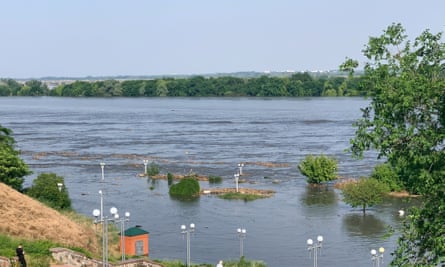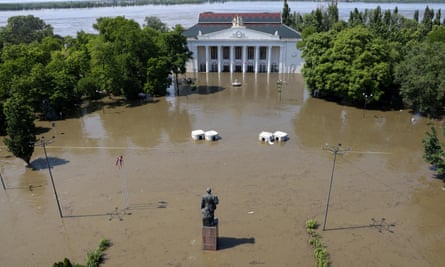In the early hours of Tuesday morning all was calm at the Kakhovka hydroelectric power station. It was a mild night. Nothing appeared to stir other than a few howling dogs. Earlier that day Russian troops had fired several dozen shells across the Dnipro River. They landed on towns and villages on the Ukrainian-controlled northern bank. A security guard was killed. Since Ukraine liberated the city of Kherson last year the war in southern Ukraine had fallen into a gruesome routine.
And then, suddenly, something terrible and extraordinary happened.
Residents living alongside the river in the occupied southern-bank town of Nova Kakhovka reported hearing a huge bang. “I was woken up by a very loud noise,” one resident, Tatyana, said. After an initial blast, she said she heard a sound that resembled water flowing – lots of it. Yelena, another local, said she was woken up by what she thought was an explosion. “We have become used to loud bangs, so I did not think it was anything serious,” she told the Guardian. She added: “It is hard to know for sure from where the blast came.”
Ukrainian officials immediately blamed Russia, saying troops occupying the hydroelectric dam deliberately blew it up at 2.50am.
Within minutes, water started cascading through the breach. Soon the crossing that spanned the Dnipro River was washed away entirely. The dam built by the Soviets in 1956 had effectively ceased to exist. A massive human and ecological catastrophe was unfolding.
For a few hours people living either side of the mighty Dnipro slumbered on. At 6am the town’s Russia-appointed mayor, Vladimir Leontyev, assured them that all was well. Pro-Kremlin military bloggers posted celebratory messages. The flood, they suggested, would prevent Ukrainian troops from crossing the river as part of a counteroffensive that was just getting under way. And it would swamp enemy positions in the grey zone – a chain of low-lying marshy islands used by Ukrainian special forces units on speedboats to carry out probing raids, they added.
By breakfast the magnitude of what was happening was apparent. It was, as Volodymyr Zelenskiy put it, Europe’s largest human-made disaster in decades. It brought back haunting memories of Chornobyl – another technological calamity that left large swathes of Ukraine barren and uninhabitable after a nuclear reactor meltdown. The Ukrainian president accused Moscow of state terrorism – an act of “ecocide” that would have vast, decades-long consequences. It was “physically impossible” for Ukraine to have blown up the dam from outside. Russia, he pointed out, had controlled it and the power plant for more than a year.
Aerial footage circulating on social media revealed a scene of devastation. Most of the dam wall had disappeared. A massive surge of water from the Khakhovka reservoir was now heading downstream. It was inundating everything in its path. That included homes and gardens, trees and vegetable patches, cars and sheds, pets and wild animals – a monstrous biblical deluge. Ukraine’s deputy prime minister, Denys Denys Shmyhal, said up to 80 settlements were at risk of severe flooding, as the torrent hurtled towards Kherson, 20 miles (30km) away. At least 16,000 people were directly affected. A race began to evacuate them.
The picture in Nova Khakovka itself was surreal. Video showed two swans gliding serenely past the town’s white-painted Stalin-era palace of culture – its central square now a giant lake. The water lapped around a statue of Lenin, newly erected in April by the Russians as part of the Kremlin’s plan to bring Russky Mir or Russian world to the areas it conquered during last year’s invasion. The local stadium was submerged. So was the riverside park, the citadel cafe, and the cinema. Khakovka’s zoo was underwater too. Its 300 animals were reported drowned. Only the zoo’s ducks appear to have been survived amid the swirling chaos.
In a bizarre video, the Moscow-installed governor of the Kherson region, Vladimir Saldo, claimed that life was continuing as normal. “I just drove through the streets. Petrol stations are working, some shops are working, even businesses are working,” Saldo said, speaking from Nova Khakovka’s town hall and dressed in military fatigues. Behind him, visible through an office window, was a spreading pool of water. The occupying authorities appear to have made little effort to evacuate civilians. Downstream, the town of Oleskhy was severely affected, social media channels said. Russian soldiers were spotted escaping in a motor boat, and trying to reach higher ground.

After initially denying anything had happened to the dam, local Russian collaborators blamed its collapse on Ukrainian shelling. Senior British defence sources said this was unlikely. They said an explosion at the bottom of the dam was the most plausible explanation. “It isn’t very difficult. No need for special forces. You put a substantial charge at the base under the water,” one former top officer said. In the run-up to the disaster, the Russians had allowed water levels to reach dangerously high levels. Pro-Kremlin Kherson officials offered a further theory: structural weaknesses and water pressure caused the reservoir wall to fail.
There was some evidence to support the idea that the collapse was the result of an accident, albeit one caused by gross Russian negligence. Last November Russian troops blew up part of the roadway across the dam during their general retreat from the northern bank of the Kherson region. The goal was to stop the Ukrainian army from advancing. Photos showed the surface was damaged and pitted. According to satellite images, last week some of the road was washed away. The reservoir’s waters were so high they reportedly started flowing over the top of the dam’s sluice gates.
But there were also compelling military reasons as to why the Russians may have blown up the dam. Ukrainian commanders acknowledge that an amphibious attack across the Dnipro River was always fraught with risk. After Tuesday, it is practically impossible. The creation of a new and treacherous impromptu flood-plain means Russian generals can redeploy soldiers from Kherson oblast to other, more vulnerable parts of the 600-mile-long frontline.
On Sunday Ukrainian troops began a tactical advance in the east, close to the administrative border between the Zaporizhzhia and Donetsk regions. Ukraine’s offensive options have now been dramatically reduced.
For the city of Kherson, the flooding was another ghastly blow. It has already endured eight months of occupation. Russian troops abandoned it last autumn but took up positions nearby, on the southern bank. They have attacked Kherson ever since using artillery rounds, mortars and tank shells. Most days these bombardments kill someone. Twenty-five civilians died in a mega-barrage last month on the city’s railway station and a supermarket. The worst affected micro-district is Ostriv, a residential island in the middle of the Dnipro, connected to Kherson by several crossings. It has come under remorseless fire.
On Tuesday Ostriv largely vanished. Its hydro-park and oil terminal were submerged first, followed by private houses – their metal roofs poking out of the water. Residents were bussed out from three assembly points; the bedridden and disabled taken by emergency workers from homes and hospitals.
Two men filmed themselves rowing in a dinghy, going from waterlogged house to house and crying: “People! Anyone there?” The poplar-lined street had been transformed into a brown Venice-style lagoon. Meanwhile, the Russians continued to shell the area. “Fuck! Incoming!” one of the men said, after a boom somewhere nearby.
The catastrophe was not entirely surprising. Last November Zelenskiy warned the international community that Russia had mined the hydroelectric station and was plotting to blow it up. He predicted this would cause a “a large-scale disaster” for anyone living downstream. And so it came to pass.
The list of villages affected by flooding on Tuesday was long: Tyaginka, Ivanivka, Mykilske Tokarivka, Ponyativka, Bilozerka and many other rural communities along the green Dnipro embankment. It was unclear when, if ever, locals would be able to return to their homes. Another video showed an entire cottage floating amid the river, its probable end-point the Black Sea. The chimney and roof were sailed along.

The disaster prompted widespread outage. The Biden administration said it was “very concerned”. The UK foreign secretary, James Cleverly – on a visit to Ukraine – said the circumstances were not yet clear, but that Russia’s full-scale invasion was ultimately to blame and “the only reason this is an issue”. Canada’s prime minister, Justin Trudeau, said the destruction was another example of the “horrific consequences” of Russia’s illegal behaviour. It would be devastating for lives and livelihoods, he said. The EU described the destruction of the dam as “barbaric” and the latest act of escalation by Russia. Ukraine’s foreign ministry, meanwhile, has sought to convene an urgent meeting of the UN’s security council.
On Tuesday night the rescue operation was expected to carry on for some time. Kherson region’s governor, Oleksandr Prokudin said nearly 1,400 people had been evacuated from the flood zone in a fleet of 50 buses. Three bridges and 71 houses had been flooded, he said, adding that water continued to cascade into towns and villages. Ihor Syrota, the boss of Ukraine’s state-owned energy company, Ukrhydroenergo, promised to reconstruct the ruined hydroelectric station once Kyiv had won the war against Moscow. “We will build a more beautiful and powerful station in the same place,” he promised.
This may be some way off.
